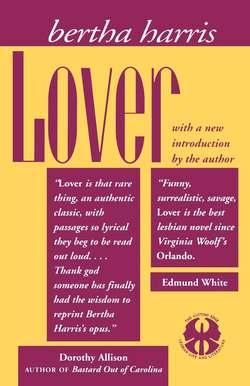Читать книгу Lover - Bertha Harris - Страница 12
На сайте Литреса книга снята с продажи.
Lover Enjoys Postmodernism: 3
ОглавлениеIn the 1960s, I saw Yvonne Rainer’s dance, ’The Mind Is a Muscle. A virtuoso dancer, Yvonne Rainer, like many postmodernist dancers-choreographers of that era, was moving against technique, especially her own technique, to abolish choreographic meaning and narrative. She freed her work from social, political, and cultural associations, and from the familiar arguments of cause and effect. She turned the body’s movement over to the play of randomness, coincidence, and chance. Her mentors were, of course, John Cage and Merce Cunningham whose music and choreography had also gone some distance in liberating me from the ordeals of purposefulness. My mind was a Zen blank as I absorbed The Mind Is a Muscle. After the performance, I thought of the noncontinuous writing of Gertrude Stein and of the ethereally discrete fiction of Ronald Firbank. The Mind Is a Muscle was a world unto itself. I wanted to make one of my own like it.
All allusions to the brain throughout Lover are emblematic of Rainer’s The Mind Is a Muscle, which was my donnée. References to cancer of the brain are memento mori, the imagination as death’s head when contaminated by exegeses. The blank spaces, the silences in Lover, where useful narrative is expected, indicate that Lover is meant to be an aesthetic rather than a useful entity. My subversive elite are recluses from usefulness and meaning: they are objets d’art.
When Lover’s character Veronica isn’t writing the fiction I’m supplying her with, she’s forging masterpieces and salting archaeological digs with fakes. Forgeries, I’m suggesting, are aesthetically at a further remove from usefulness and meaning than their originals. As mirror-images, duplicates, twins, of the originals, they are better art. Within the secluding perimeters of Lover, women are the originals, lesbians are the forgeries.
I would rather my character Flynn to have sprung fullgrown from my brain (mine, not Zeus’) than descend from a womb: but I don’t write fantasy. The mothers in Lover must make themselves reproductively useful before they may enjoy ecstacy. Motherhood in Lover is the real worm in the bowl of wax fruit: which is Lover. Every biological reality in Lover, but especially motherhood, contaminates the aesthetic surround.
I abstracted the character of Maryann from the brilliant and complex personality of Jill Johnston who, during the sixties, had become my literary hero. Her writing had nerve. Much of Lover’s deliberate plotlessness, which I hoped would affect the reader as a delirious spin, spins around Maryann, my idea of the lesbian’s lesbian.
Jill Johnston had already established herself as the most knowledgeble and sensitive critic of New York’s avantgarde when, in the mid-sixties, she began to turn her Village Voice dance column—which was always about much more than dance—into a gorgeous performance of radical self-psychoanalysis, introspection, self-revelation. She began to apply the wit, erudition, comic turns, intellectual acuity, and artistic discernment, for which she was already famous, to an in-public exposure of her own life. Jill Johnston became her own subject: the “dance” of her column became Jill’s illuminating dance through the details of her own life and mind.
Shortly after the Stonewall revolution in 1969, Jill came out in print like gangbusters and became my sex hero. Her Voice columns were collected under the titles Marmalade Me (1970), and Lesbian Nation: The Feminist Solution (1973).
